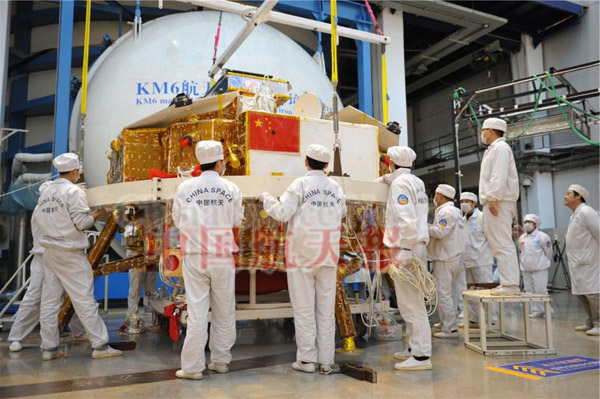 |
| File photo(Photo source:Xinhua/chinanews.com) |
China to launch Chang'e-3 lunar probe in early Dec.
China will launch a lunar probe, Chang'e-3 in early December, the State Administration of Science, Technology and Industry for National Defense announced Tuesday morning in Beijing.
The Chang'e-3 satellite and its carrier, the Long March-3B, are now in Xichang city of Sichuan province. The probe will be blasted into space within the first 10 days of December, Wu Zhijian, spokesman for the agency, told a press conference.
The lunar probe will conduct a soft landing on the moon's surface.
It will carry a special moon rover for detailed exploration and collection of lunar soil and stone samples.[Read More]
Press conference held in Beijing to introduce China's lunar probe
Chang'e-3 encompasses a lander and a moon rover called "Yutu" (Jade Rabbit). The lunar probe will land on the moon in mid-December if everything is successful, said Wu Zhijian, spokesman with State Administration of Science, Technology and Industry for National Defence.
The Chang'e-3 mission is the second phase of China's lunar program, which includes orbiting, landing and returning to Earth. It follows the success of the Chang'e-1 and Chang'e-2 missions in 2007 and 2010.
Chinese scientists have made technological breakthroughs for the Chang'e-3 mission, which will be the most complicated and difficult task in China's space exploration, Wu said.
"More than 80 percent of the technologies adopted in the mission are new," he said.
The mission will witness China's first soft landing and exploration on an extraterrestrial object, remote control of the lunar probe and deep space communications, Wu said. [Read More]
Timeline of China's lunar program
China's lunar mission is divided into three stages: orbiting, landing, and return. Following is the timeline of China's lunar mission development.
1998 Commission for Science, Technology and Industry for National Defense (COSTIND) begins planning the lunar mission, tackling major scientific and technological problems;
2004 January - lunar orbiter project is formally established;
February - mission is named "Project Chang'e" after a mythical Chinese goddess who flew to the moon;
2007 Oct. 24 - Chang'e-1 is successfully launched;
Nov. 7 - Chang'e-1 enters lunar orbit;
Nov. 26 - a clip of the voice of the probe and a Chinese song "Ode to the Motherland" are sent back from orbit. China's first picture of the lunar surface is published by Xinhua News Agency;
2008 Jan. 31 - COSTIND publishes the first picture of the lunar polar region taken by Chang'e-1;
October - the State Council, China's Cabinet, approves the Chang'e-2 mission;
Nov. 12 - based on data collected by Chang'e-1, the first lunar hologram with a resolution of 7 meters is published;
2009 March 1 - Chang'e-1 impacts the moon under control;
2010 Oct. 1 - Chang'e-2 is sent into space aboard a Long March-3C carrier rocket from southwest China's Xichang satellite launch center;
Oct. 9 - Chang'e-2 enters 100-km circular lunar orbit;
Oct. 26 - Chang'e-2 enters lower, elliptical orbit; prepares to photograph Sinus Iridium;
Oct. 29 - Chang'e-2 photographs Sinus Iridium and returns to a higher orbit;
Nov. 8 - pictures of Sinus Iridium published by the State Administration for Science, Technology and Industry for National Defence (SASTIND);
2011 April 1 - Chang'e-2 completes all six engineering objectives and four scientific missions. Its design lifetime expires;
April to the end of May - Chang'e-2 surveys south and north poles of the moon, and takes high-resolution pictures of the chosen landing site for Chang'e-3;
Aug. 25 - For the first time in history, from lunar orbit a space craft enters the second Lagrange Point (L2) orbit, where gravity of the sun and Earth balance the orbital motion of the satellite;
2012 Feb. 6 - SASTIND publishes a lunar hologram with a resolution of 7 meters;
Dec. 13 - Chang'e-2 arrives in deep space 7 million km away from Earth, and surveys the Tout asteroid;
Present Chang'e-2 is 60 million km away from Earth and has become China's first man-made asteroid in the solar system. It continues flying into deeper space. [Read More]
More reports on China's space exploration:
>>>Shenzhou-10 manned spacecraft mission
>>>China's Shenzhou-9 mission

 Finland has more eggs in the Chinese basket than any other
Finland has more eggs in the Chinese basket than any other In pictures: PLA's digital equipment
In pictures: PLA's digital equipment  Protesters demonstrate during UN Climate Change Conference in Poland
Protesters demonstrate during UN Climate Change Conference in Poland  Self-made farmer billionaire donates 69 villas at hometown
Self-made farmer billionaire donates 69 villas at hometown Demolition of bizarre rooftop villa in Beijing still in progress
Demolition of bizarre rooftop villa in Beijing still in progress Service seminar for E China train attendants
Service seminar for E China train attendants  Supermodel-turned-designer
Supermodel-turned-designer Cheerleaders light up CBA regular season
Cheerleaders light up CBA regular season  Finland--anytime you want is right time to go: Ambassador
Finland--anytime you want is right time to go: Ambassador Maritime counter-terrorism drill
Maritime counter-terrorism drill Splendid views of cities blanketed with fog
Splendid views of cities blanketed with fog  Models dazzle at Int'l Yacht Model Pageant
Models dazzle at Int'l Yacht Model Pageant  How to apply for a green card in China
How to apply for a green card in China Annual Santa Claus parade held in Canada's Montreal
Annual Santa Claus parade held in Canada's Montreal Weekly Sports Photos
Weekly Sports PhotosDay|Week|Month